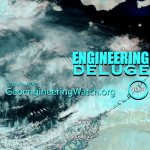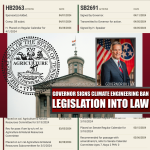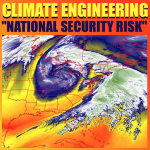Climate Engineering Denial, The Deliberate Deception

WIth almost no exceptions, the entire climate science community is completely denying the blatantly obvious and verifiable geoengineering reality. The all out aerosol spraying of skies around the globe is absolutely inarguable and yet the climate scientists/meteorologists are still pretending geoengineering is only a "proposal". How can we explain the total denial of this reality coming from climate scientists? They fit into one of these categories, they are either completely unqualified for the job they hold, afraid to speak out, willing to lie to protect a paycheck and a pension, or they are clinically blind. None of these reasons are justification for the total deception being fed to us from the so called "experts" that are entrusted with the public welfare. We have long since lived in an Orwellian world but now it has reached a point that is difficult to even comprehend. Articles like the one below are laden with direct lies and lies of omission. They try to paint the picture that a small fleet of jets spraying aerosols into the atmosphere could cool the planet. That the only thing we need to worry about is who will control the thermostat. After 65 years of geoengineering on an ever larger scale, now involving what is likely thousands of jets, with a planet that is rapidly descending into total meltdown, we can say with total certainty solar radiation management is only making a bad climate situation far worse. Virtually none of the known unavoidable major negative consequences of SRM are even mentioned in most mainstream articles. Total disruption of the hydrological cycle, shredded ozone layer, lack of direct sunlight, and what is never ever mentioned is the fact that what goes up, must come down. Virtually the entire surface of the planet is being systematically contaminated, as is every single breath we take. How is it that this last and most dire point is never mentioned in any mainstream media articles or even in the science studies about aerosol geoengineering? Are we to think that thousands of climate scientists cannot comprehend this fact? That something sprayed into the atmosphere must settle down to Earth? Most of the climate science community should be viewed with contempt for their part in this greatest of all human crimes. Once the public is fully aware of what has been done to them, legal action should be immediately taken against all those that willfully participated in the completely illegal climate engineering assault, or in the criminal attempt to cover up these lethal programs. Make your voice heard in this battle. This does not mean to simply complain, but to help wake others up by passing on credible data on the climate engineering issue.
Dane Wigington
geoengineeringwatch.org
The Economics Of Climate Engineering
Source: Geoengineering Our Climate
Moreno-Cruz et al (2015) – The Economics of Climate Engineering – Click for Download
Unmitigated climate change is extremely costly. Mitigation (the reduction of carbon dioxide and other greenhouse gas emissions at the source) is the only prudent response. While upfront costs can be high, in the long run mitigation is relatively cheap and because it tackles the root cause of the problem, its benefits are permanent and transparent. However, because the effects of mitigation investments are subject to considerable physical and social inertia, they are slow to manifest. Moreover, effective mitigation requires overcoming the well-known “free rider” effect inherent in the most global of global commons problems.
Enter climate engineering in the form of planetary albedo modification, or Solar Radiation Management (SRM). Although it is both cheap and fast, SRM is clearly an imperfect method of countering climate change. Rather than addressing global warming’s root cause, it counteracts its effects with additional pollution. But SRM is so cheap that direct private costs largely do not play a role in the decision process of whether (and how) to pursue it.[1] Well-designed SRM systems could cost less than $10 billion per year to stabilize global temperatures. That places implementation within the budget of many countries, making SRM perhaps 100 times cheaper than any emissions reduction program to stabilize global average temperatures below a post-industrial increase of 2°C.[2] It is so fast that it can reduce planetary temperature in days, weeks or months, compared to the decades or centuries that emissions reductions would take to have a similar effect.
“Fast, cheap and imperfect” give SRM virtually the exact opposite economic properties from mitigation. Instead of the “free-rider“ effect in which actors are compelled to underprovide mitigation, the chief economic characteristic comes much closer to a “free-driver” effect in which actors are compelled to overprovide SRM.[3] In terms of policy interventions, this means that rather than pursuing individual actors to mitigate counter to their immediate personal interest, the task becomes one of reining in those who want to pursue climate engineering of their own volition.
Economic Tools to Analyze SRM
Two types of standard economic tools are most prominent in the economic analysis of geoengineering: benefit-cost analysis and game theory.
Benefit-cost analysis attempts to weigh the full set of benefits and costs of any policy intervention (in this case, SRM) to make informed decisions. To identify the optimal policy, researchers make assumptions about social benefits and costs associated with both SRM and mitigation, and the damages associated with unmitigated climate change. The optimal policy balances the benefits of action against the costs associated to the action taken.
Well-known problems exist in the application of conventional benefit-cost analysis to problems of global-scale change.[4] One inherent problem with such analyses is their reliance on an assumption of modest and quantifiable uncertainty.[5] In the case of SRM, estimates of both climate change’s damages, and the costs of geoengineering fail to meet this criterion. While we have a relatively good handle of the direct, private costs associated with SRM, the full sets of social costs—and the full social benefits, for that matter—are largely a mystery.[6]
Perhaps an even more fundamental problem with these kinds of benefit-costs analyses is that they largely assume optimally coordinated decisions across regions or countries. In particular, they ask: what are the total benefits and costs of SRM from a benevolent, global social planner’s perspective seeking to optimize policy for the world? Reality, of course, does not conform to this assumption.
This is where game-theoretic and political economy studies come to play. Game theory provides a tool to reveal frictions that arise when self-interest actors wish to maximize their own well-being without considering the full effects of their actions on others. Instead of optimizing outcomes from the perspective of a single decision maker, in a game theoretic model multiple players interact and make strategic decisions to optimize their own individual outcomes.
The primary limitation of game theoretic analyses of SRM to date may be a lack of any consensus over the key constraints that would govern strategic interactions in a geoengineered world. Different assumptions about how physical effects of SRM translate into economic damages, what the institutional characteristics of a sustainable geoengineering implementation program would be or even who could feasibly get away with setting the global thermostat without consent from other world powers lead to drastically different conclusions about what outcomes are possible.[7] The sensitivity of the outcomes predicted by game-theoretic analyses to their model constraints implies that as uncertain and unpredictable as the science of SRM may be, political dynamics likely play an even more important factor in shaping the final outcome.
Rogue Actor, Rational Portfolio, and Worst-case Insurance
Current international legal standards do not explicitly restrict any nation from engaging in stratospheric SRM.[8] It is unlikely that even if they did, that such restrictions could effectively block action, just as the Nuclear Non-Proliferation Treaty did not prevent non-signatories like India, Israel, North Korea and Pakistan from developing nuclear weapons. Both legally and technically, a single nation or even a wealthy individual could take matters into their own hands. Unilateral SRM deployment could lead to the alleviation of climate change impacts for one group while imposing a mix of externalities on another group without its consent or compensation. Underestimating the full benefits and especially costs may only be a small issue in this situation. Full-on “climate wars”—with geoengineering and counter-geoengineering efforts—would be quite another. This is one of the reasons it is important to understand the potential harm and benefits associated with SRM, not only globally, but also in terms of relative regional effects, and important for responsible actors to develop governing mechanisms for careful, deliberate geoengineering research.
A deliberate approach to SRM may also link into two other potential geoengineering scenarios: SRM as part of a portfolio of strategies to address climate change, or as a deliberate backstop technological response to a global climatic emergency. The two are not mutually exclusive. They also come with their individual challenges.
As a part of a portfolio of strategies, together with mitigation and adaptation, SRM could in theory be used to achieve an ‘optimal’ response to climate change, minimizing net social cost or maximizing some other global, societal objective.[9] This framing is controversial for a host of reasons. For one, fundamental uncertainties of the underlying climate and ecological science may make a deliberate, deterministic choice difficult to impossible. Another reason is the host of ethical issues involved in intentionally engineering the planet. Moreover, the decision process is murky. There is no single global decision maker for whom an optimum can be defined. Solving any of these challenges is difficult, to say the least.
Political economics could conceive of rational voting mechanisms that do define a globally optimal solution, though the practical difficulties of implementing any such scheme would be daunting.[10] Alternatively, countries could engage in negotiations to create a coalition with enough power to legitimize the “free-driver” intervention while excluding a majority of countries.[11]
A perhaps less controversial argument is that SRM could serve as a form of insurance of last resort, in case of a worst-case climatic scenario. Likely climate outcomes should provide sufficient impetus for action on mitigation. But, it may be the low-probability, high-impact events that dwarf any and all currently projected, average costs. A conservative calibration of what is known about climate sensitivity—the effect on eventual global average temperatures as greenhouse gas concentrations in the atmosphere rise—indicates that we are well underway toward a world with a greater-than 10 percent chance of global average temperatures rising above 6°C.[12] Such a scenario may well trigger a host of, irreversible, tipping points, many of which could occur much closer to the vaunted 2°C threshold.[13]
Such tipping elements include the disappearance of Arctic summer sea-ice (a process well underway), rapid decay of the Greenland ice sheet, or the collapse of the ocean’s thermohaline circulation. It’s clear that the potentially dire economic consequences of such phenomena contribute disproportionately to the risks associated with global warming. The extent to which SRM could stop or slow the progression of extreme climate change after its commencement or detection is unknown. That makes seeking insurance against worst-case scenarios a primary reason cited for investing in SRM research.[14]
The insurance proposal does not come without drawbacks. For example, the technology would be developed by the current generation and would be implemented by a future generation; resulting in time inconsistency and sub-optimal use of the technology by future generations.[15] Nonetheless, the downside risks of unmitigated climate change might be so large that virtually any intervention might pass a benefit-cost test.
From Incredible to Seemingly Inevitable
Perhaps the most apt description of the economics of geoengineering came in one of the very first articles on the topic. Barrett (2008) described it as “incredible,” referring to the small costs of SRM. In fact, the costs are so small, they turn the standard economics of climate change as a global commons problem on its head—from the “free rider” to the “free driver” problem.
The very same fundamental market forces that make mitigation action so hard seem to point directly towards an SRM-style intervention. None of this should be misconstrued as an endorsement of this path. Quite the opposite: it’s a call for a deliberate step toward a governing mechanism that could guide these market forces in the right direction.[16]
Works Cited
Barrett, S. 2008. “The Incredible Economics of Geoengineering.” Environmental and Resource Economics 39: 45-54.
Barrett, S. 2014. “Solar Geoengineering’s Brave New World: Thoughts on the Governance of an Unprecedented Technology.” Review of Environmental Economics and Policy 8(2): 249–69.
Goechl, T., D. Heyen and J. Moreno-Cruz. 2013. “The Intergenerational Transfer of Solar Radiation Management Capabilities and Atmospheric Carbon Stocks.” Environmental and Resource Economics, DOI 10.1007/s10640-013-9647-x
Goes, M., N. Tuana and K. Keller. 2011. “The Economics (or Lack Thereof) of Aerosol Geoengineering.” Climatic Change 109(3-4): 719-744.
Hanafi, A., and S.P. Hamburg, 2013. ”The Solar Radiation Management Governance Initiative: Advancing the International Governance of Geoengineering Research.” Geoengineering Our Climate? Working Paper Series. Opinion Article, 30 April.
IGBP, IOC, SCOR. 2013. “Ocean Acidification Summary for Policymakers – Third Symposium on the Ocean in a High-CO2 World.” International Geosphere-Biosphere Programme, Stockholm, Sweden.
Keith, D.W. 2013. A Case for Climate Engineering. Boston: MIT Press.
Keith, D.W. 2010. “Photophoretic Levitation of Engineered Aerosols for Geoengineering.” Proceedings of the National Academy of Sciences 107(38): 16428-16431.
Keith, D.W., E. Parson, and M.G. Morgan. 2010. “Research on Global Sun Block Needed Now.” Nature 463(28): 426-427.
Kirk-Davidoff, D.B., E.J. Hintsa, J.G. Anderson, and D.W. Keith. 1999. “The Effect of Climate Change on Ozone Depletion Through Changes in Stratospheric Water Vapor.” Nature 402(6760): 399-401.
Lenton, T.M. , H. Held, E. Kriegler, J.W. Hall, W. Lucht, S. Rahmstorf, and H.J. Schellnhuber. “Tipping Elements in the Earth’s Climate System.” Proceedings of the National Academy of Sciences 105(6): 1786–1793.
McClellan, J., D. Keith and J. Apt. 2010. “Cost Analysis of Stratospheric Albedo Modification Delivery Systems.” Environmental Research Letters 7: 034019
Millard-Ball, A. 2012. “The Tuvalu Syndrome.” Climatic Change 110(3-4):1047-1066.
Morgan, M.G., M. Kandlikar, J. Risbey, and H. Dowlatabadi. 1999. “Why Conventional Tools for Policy Analysis are Often Inadequate for Problems of Global Change. Climatic Change 41(3): 271-281.
Morgan, M.G. and K.L. Ricke. 2010. “Cooling the Earth Through Solar Radiation Management: The Need for Research and an Approach to its Governance.” Technical Report. International Risk Governance Council.
Moreno-Cruz, J. 2015. “Mitigation and the Geoengineering Threat.” GT SOE Working Paper. Available at: http://works.bepress.com/morenocruz/3/ Accessed 30 Jan.
Moreno-Cruz, J., K.L. Ricke and D.W. Keith. 2011. “A Simple Model to Account for the Regional Inequalities in the Effectiveness of Solar Radiation Management.” Climatic Change 110: 649-68.
Moreno-Cruz, J. and D.W. Keith. 2012. “Climate Policy under Uncertainty: A Case for Geoengineering.” Climatic Change 110(3-4): 649-668.
Ricke, K.L., M.G. Morgan and M.R. Allen. “Regional Climate Response to Solar Radiation Management.” Nature Geosciences 3: 537–41.
Ricke, K.L., J. Moreno-Cruz and K. Caldeira “Strategic Incentives for Climate Coalitions to Exclude Broad Participation.” Environmental Research Letters 8: 014021.
Rogelj, J., M. Meinshausen and R. Knutti. 2012.“Global Warming under Old and New Scenarios Using IPCC Climate Sensitivity Range Estimates.” Nature Climate Change 2: 248–253
Shepherd, J., K. Caldeira, J. Haigh, D. Keith, B. Launder, G. Mace, G. MacKerron, J. Pyle, S. Rayner, C. Redgwell, and A. Watson. 2009. Geoengineering the Climate: Science, Governance and Uncertainty. Technical Report. Royal Society.
Tilmes S., R.R. Garcia, D.E. Kinnison, A. Gettelman, and P.J. Rasch. 2009. “Impact of Geoengineered Aerosols on the Troposphere and Stratosphere.” Journal of Geophysical Research, 114(D12): 6.
Urpelainen, J. 2012. “Geoengineering and Global Warming: a Strategic Perspective.” International Environmental Agreements: Politics, Law and Economics 12(4): 375-389.
Wagner, G. and M.L. Weitzman. 2015. Climate Shock: the Economic Consequences of a Hotter Planet. New Jersey: Princeton University Press.
Weitzman, M.L. Forthcoming. A Voting Architecture for the Governance of Free-Driver Externalities, with Application to Geoengineering. Scandinavian Journal of Economics.
[1] For example, see Barrett 2008, 2014; Moreno-Cruz and Keith 2012; Keith 2013; Wagner and Weitzman 2015
[2] Morgan and Ricke 2010; McClellan et al. 2010
[3] Weitzman 2013; Wagner and Weitzman 2015
[4] Morgan et al. 1999
[5] Goes et al. 2011
[6] Moreno-Cruz and Keith 2012; Wagner and Weitzman 2015
[7] Ricke et al. 2013; Millard-Ball 2012; Moreno-Cruz 2012; Urpelainen 2012
[8] Parson and Ernst 2013
[9] Moreno-Cruz et al. 2011; Moreno-Cruz and Keith 2012
[10] Weitzman, forthcoming; Wagner and Weitzman 2015
[11] Ricke et al. 2013
[12] Rogelj et al 2012, Wagner and Weitzman, 2015
[13] Lenton et al. 2008
[14] Morgan and Ricke 2010; Shepherd et al. 2009
[16] Hanafi and Hamburg 2013
Source: Geoengineering Our Climate













































































































































Readers need to pay attention to the "educational" grants systems that guild the pockets of lying assholes like those above. These actors and actresses (paid liars) should by sprayed with WD-40 until they hemorage from every orfice…
I cannot believe that humans are so stupid to do what they are doing. Any half brained person would recognize what is wrong with what is going on. I am amazed with what we have achieved in our tiny time frame of existence in the evolutionary history of this world. There is definitely a spot for us in the fossil record. The sooner we go the better. We have destroyed so much of this beautiful planet already that we will go down as being the most destructive species that has ever given the chance on this world. It is a real pity as if we used our special ability to think we could have done so much more good and developed a wonderful world. Our greed and quest to achieve it has been our down fall and the sooner we are eliminated from this planet the better for all.
We are a unique species with the unfortunate quality to know that we know so we know death and want everlasting life, hence religion. We fear death and didn't understand it and don't want to die. We keep procreating to keep the economy going but forget that we live on a planet wit limited resources. We think we are clever but we are not wise and have a spot marked in the fossil record. We are just an experiment in evolution which has proved to be unsuccessful and the sooner we are removed from the equation of life the better it will be for those who remain. Cheers!!
And it's amazing how they've kept it secret for so many years too! Not one airpline pilot, or line crew or aircraft mechanic or airplane manfacturing worker, aviation fuel distalation plant worker … nody has ceom forward to admit his astrocity. Imagine, you are a retired airline pilot who was forced to accept a posion additive in the fuel for years, and even now you can't say anything because they have such a hold over you. Any day now I expect somebody is going talk…
"Fast, cheap, and imperfect?" Are you guys kidding me? The glibness and heartlessness of the discussion throughout the shank of this article that pretends to examine SRM from a variety of angles without the slightest acknowledgement (except in passing) that to spray deadly toxic nano-aerosols over the entire planet just might have a concomitant effect on human, animal and plant health! Unbelievably dry, academic, heartless overview of geoengineering while sidestepping the real, genuine, HUMAN AND ENVIRONMENTAL ISSUES!!!!
And here again……how repulsive, clueless and STUPID to go on and on about how CHEAP geoengineering is in relation to it's desired effects! AS IF THERE IS NO COST ASSOCIATED WITH VIRTUALLY PERMANENT CONTAMINATION OF THE SOILS, THE WATERS, THE BIOSPHERE, AND ALL OF CREATION HERE ON PLANET EARTH???!!!?? Are the authors of this piece even human?
Hi Mark: You asked if the authors of this pointless analysis are even human. Nope. They're a product of Wall Street "thinking". An educational system that trains people to be pocket calculators is not an educational system. It's a potty training system.
If they don't get caught with a pants full of shit, they'll pass the exam with flying colors. To bad they're shit stinks to high heaven, and they haven't been called out about it…
If I wind up dying from this spraying crap which is slowly killing me I am planning to sue God and the spiritual *Brotherhood* for neglect since they are turning the *other cheek* to these big corporation monsters.
There is NOT going to be a later. Action needs to be NOW or there won't be a chance and they will come to a dead planet unless that's what the brotherhood wants is for most of us to die then they can make a new pristine earth which the human race is a no go.
Being relatively new to this, I was interested to see that the UK Guardian posted an article on geoengineering yesterday (which I referenced in Dane's 'Record Media Coverage of Climate Engineering' Article comments) where they at least admit that it is open to bypassing red tape and covert use. This got me searching their archives and I found this from 2012. Am I reading this wrong, or isn't this at least an admission that experimentation is taking place and is heaviest in the UK, parts of Europe and USA?? Please correct me if I am wrong!
http://www.theguardian.com/environment/graphic/2012/jul/17/geoengineering-world-map
http://www.weathermodification.com/projects.php This business actually does tours and explains their business: Spraying the sky.
I have found that there really are NO layers to this so called onion that we are all investigating. Just one big rotten mass creating death and the depopulation objective of Agenda 21.
Hello Steve, though the final result is as you stated, the situatioin does in fact have many layers including opposing interests with competing global powers. Still, the consequences are the same in the end if these programs are allowed to continue. Its up to all of us to keep up our efforts to expose the insanity.
This petition regarding chemtrails just became active on the white house gov site. Please sign it and move it forward, especially on facebook
https://petitions.whitehouse.gov/petition/immediately-stop-aerosol-spraying-our-nations-skies/7XqYfH9z
http://www.youtube.com/watch?v=RDxQPRnIMdA
Fast and Furious airplane brainwashing clip.
This petition has only a few hundred names– it needs 100,000!
We seem to be helplessly assaulted daily by spraying, HAARP arrays bendind and distorting weather patterns i.e. drought, polar vortex winters in deadly recordsetting intensities. MSM meteorologists say that these are once in a hundred year occurrences that are “puzzling”. Meanwhile th masses nod their heads and doubt that anything could be happening that the “government” would morally do to damage the lives of trusting citizens.
The ugly truth will eventually surface, but my fear is that it will only happen if a “worst case scenario” event happens and is hidden or misrepresented until it is literally too late or too impossible to control. When THAT cat gets out of the bag we will be in very deep, very deadly shit. I pray I’m wrong but the more I look at the silver sky the less confident I feel that this all will come to a positive end. Keep the pressure on. Don’t be afraid to point to the sky and ask WHY?
Dear Humans,
I can only hope that we find a way to stop the spraying soon. I am finding it difficult to breath by the day, with the congestion getting worse. Memory recall ability diminishing and level of confusion on the rise too. I am not sure how much longer I will be alive!
Scott in Florida
Scott, I really feel for you. I'm in the UK and feel the same way as you. Two years ago I was healthy and fit and had no problems. Now I have "unexplained" neurological problems which have been investigated but put down to "migraine" because they have no answer for my daily headaches, dizziness, tinnitus and visual problems. After months of trying diet changes, then thinking it was down to air pressure I started looking up…..have now learned which type of skies will give me what symptoms! I have oto have an MRI on my brain on Saturday and now feel scared because I don't know if aluminium in my brain would react?? can anyone tell me? you are not suppose to have metal implants apparently,
Scarily, I have a new one. On heavily saturated days we now have low flying military jets which we can't see, just hear and you can't pick them up on flight radar apps plus we are nowhere near an airfield!) and on those days I get very ill with flu like symptoms, sore throat and a horrible cough. It's on those days I can't breath (like you) and now have to use an inhaler. Today is one of those days and it feels like the last straw. I have been working today and it's been like trying to function through a thick mental fog. I almost wish we could have the blue skies with white chemtrails back….
In the END, those still clinging to life will clearly understand that this was all done to achieve the objectives of Agenda 21, Period.
So what are we to assume from the above article? Geoengineering is cheap. Woopy do. No mention of global biological destruction, militarisation of the weather or its contribution to climate change.
We are decades into being geoengineered and everything is falling apart and climate change is rampant. The above article is virtually saying we are going to have to use Geoengineering, so I will assume the article is a ruse written by a hired shill to provide a thin argument to start the process of increasing public acceptance of this 'program-to-be'.
What about someone writing solely about carbon mitigation and sequestration for once? Why can't they focus on real solutions to carbon through reduction of its production and then capturing what has already been released? We know there are plenty of ideas. The same billionaires that fund Geoengineering could start funding these real measures that will fix things up.
But what a naive fool I am. Where is the quick profit is helping people? War, resource control, population control, dinosaur carbon technologies, debt based economies, taxation, inflation and so on. I almost forgot about all that fun stuff!
Thank you again Dane, for speaking up. I know you're right; I can see and feel the effects all around me almost daily. Our soils have eroded and our trees and plants are in bad shape. It's hard to grow anything good outdoors anymore, and the birds, bees, frogs, insects and small forest animals are diminishing in front of my eyes. Everyone is having auto-immune issues. I know how serious these programs are, and to witness the complete denial or short-sightedness of the academic community is appalling. These programs are being used for military applications, another black budget hell hole that serves no one except those feeding the programs, and we all know weather futures are being traded on the open markets. It's time to reign these programs in.
I can’t say for sure, and I don’t know if it is true for each country.
But as far as I know there seems to be in addition to "paycheck" and "clinically blind" the option that meteorologists are subordinated to the military and may not be allowed to report certain events.
Dane – thank you for another excellent report!
NASA/Military/Climate Engineering community, which means a VAST amount of actors involved, have given us repeated full scale lies about everything else relating to weather warfare, so I ask why would they now be telling the truth about SRM?
They boldly march on trampling the earth & hemisphere with their ecocidal agenda. We witness this by the continuation of world-wide spraying, HAARP, oceanic fertilization, etc. Also the fact that their agenda was long ago announced to own the weather by 2025!
This program of SRM is being run by either psychopaths,socio paths, idiots or all of the above. The respiratory illnesses alone should be enough to make people wonder why we are getting sicker more often.As long as the hen house is run by the greedy,out of control, wolves we are in for the ride of our life.The lies and deception in our government and our society can only lead to one thing,death and destruction. Seems it may take a catastrophic event before people will wake up and realize there are some very nefarious players who don't care about humanity.